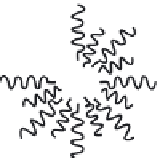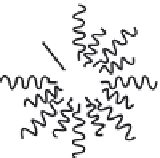Biomedical Engineering Reference
In-Depth Information
C
A
R
B
O
N
y
p
FIGURE 14.7
Schematic illustration of an electrochemical immunoassay based on the poly[G]-func-
tionalized silica NPs on carbon electrode. Diamond stands for the mouse IgG; “Y” shape for mouse anti-
body; red strings for poly[G] (reproduced from [62] with permission) (see Plate 16 for color version).
per antibody-antigen-antibody complex formed. This immunobiosensor is very sensi-
tive, and the limit of detection was found to be down to 0.02 ng mL
1
. An attractive fea-
ture of this approach is that it makes it feasible to develop a cheap, sensitive, and portable
device for multiplexed diagnoses of different proteins. This method is simple, selective,
and reproducible for trace protein analysis and can be extended to study protein-protein,
peptide-protein, and DNA-protein interactions.
14.5 CONCLUSION AND OUTLOOK
Nanotechnology offers unique opportunities for designing ultrasensitive biosen-
sors and bioassays. The studies described above demonstrate the broad potential of
bioconjugated nanoparticles for amplifi ed transduction of biomolecular recognition
events. Given the optical and electrochemical applications, such nanoparticle labels
provide the basis for ultrasensitive assays of proteins and nucleic acids. The remark-
able sensitivity of the new nanoparticle-based sensing protocols opens up the possi-
bility for detecting disease markers, biothreat agents, or infectious agents that cannot
be measured by conventional methods. Such highly sensitive biodetection schemes
could provide early detection of diseases or a warning of a terrorist attack. The use
of nanoparticle tags for detecting proteins is still in its infancy, but the lessons learned
in ultrasensitive DNA detection should provide useful starting points. The successful
realization of the new signal-amplifi cation strategies requires proper attention to non-
specifi c adsorption issues that commonly control the detectability of bioaffi nity assays.
Proper washing and surface blocking steps should thus be employed to avoid amplifi ca-
tion of background signals (associated with non-specifi c adsorption of the nanoparticle







































Search WWH ::

Custom Search